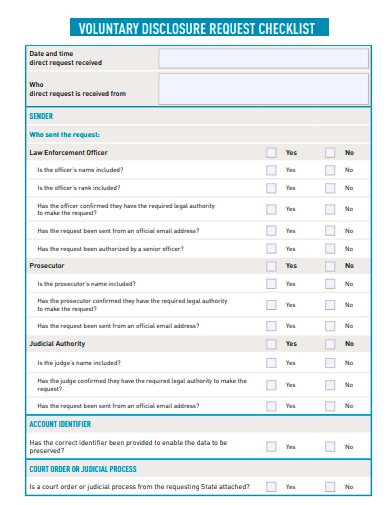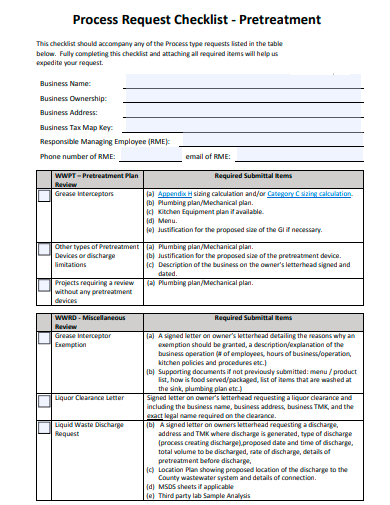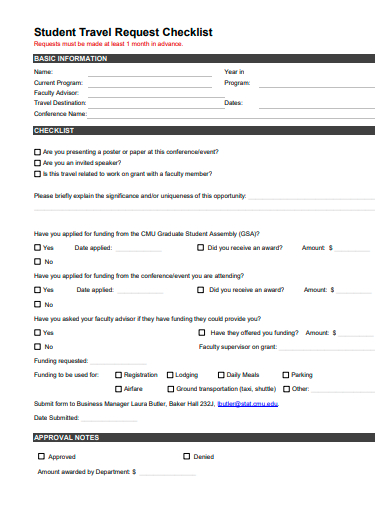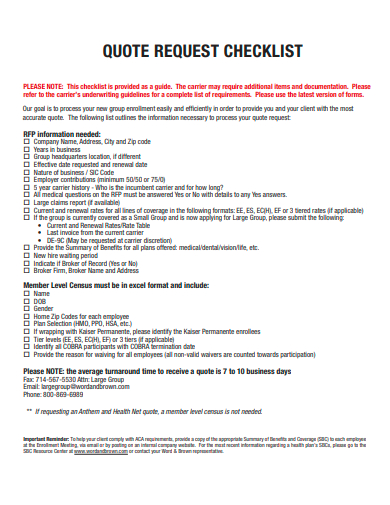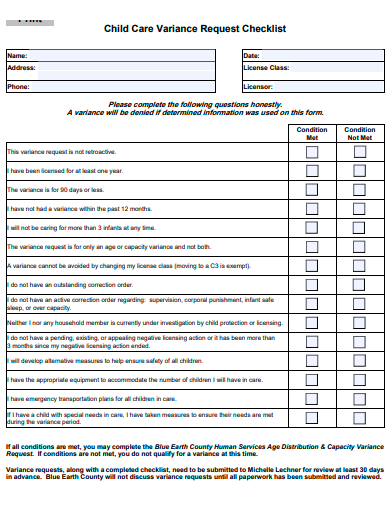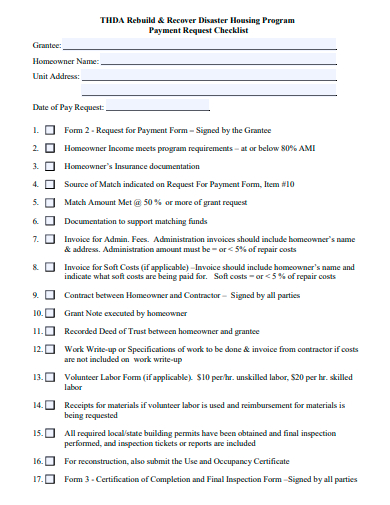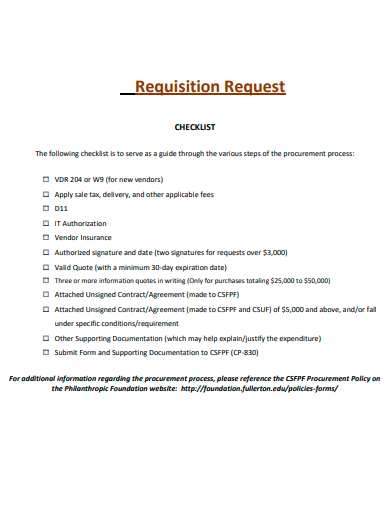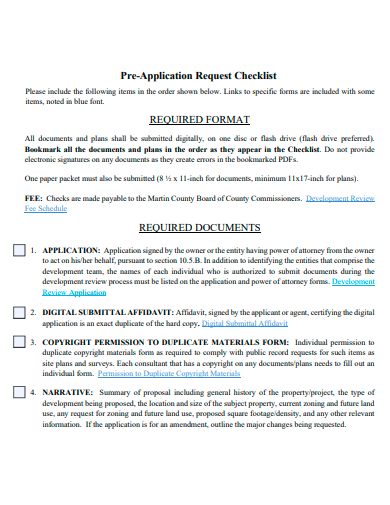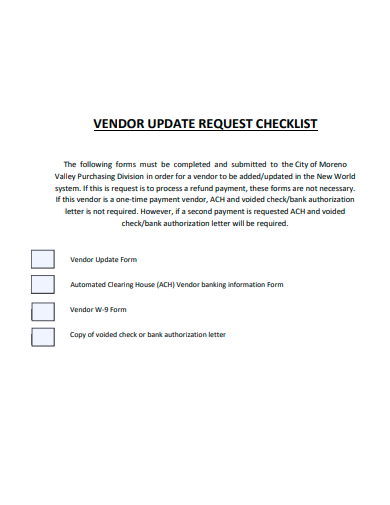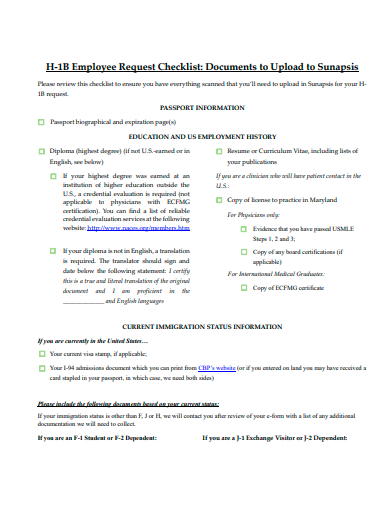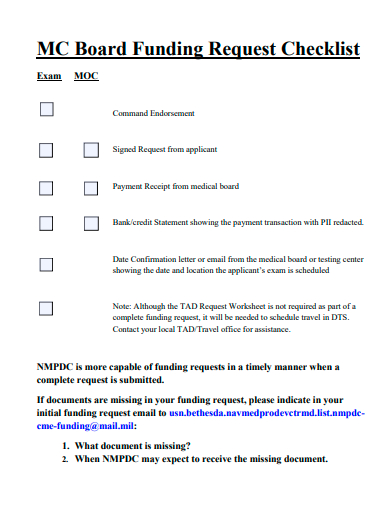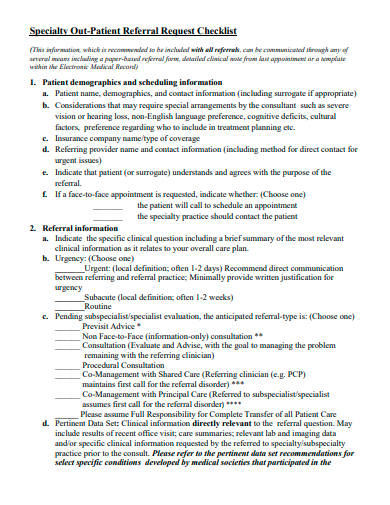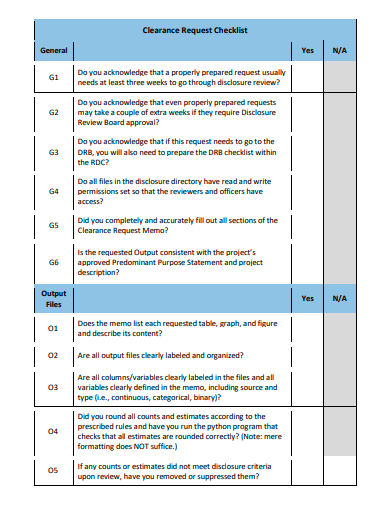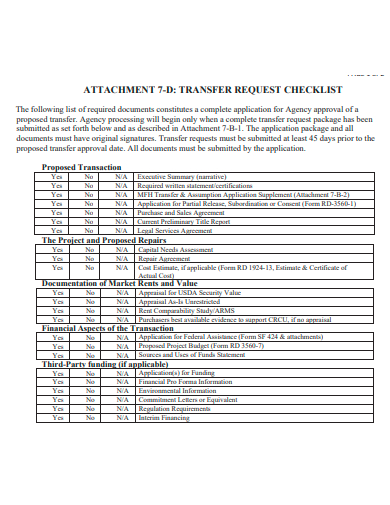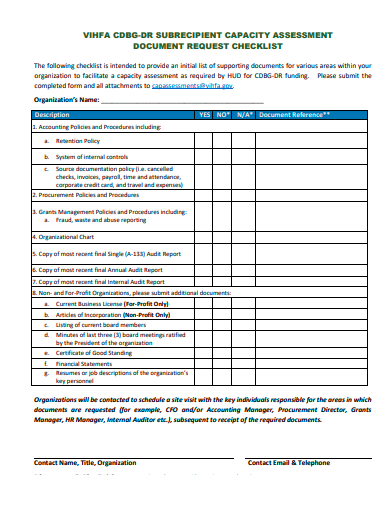In today’s fast-paced digital environment, ensuring every request is addressed efficiently is crucial. The ‘Request Checklist’ serves as a comprehensive guide to streamline tasks, ensuring nothing falls through the cracks. Rich with actionable items, this sample checklist is a must-have tool for professionals aiming to optimize their workflows. From initial inquiry to task completion, this resource simplifies the process, enhancing productivity and ensuring every detail is covered. Dive in to make your request management seamless.
18+ Request Checklist Samples
1. Sample Checklist Template

2. Basic Checklist Template
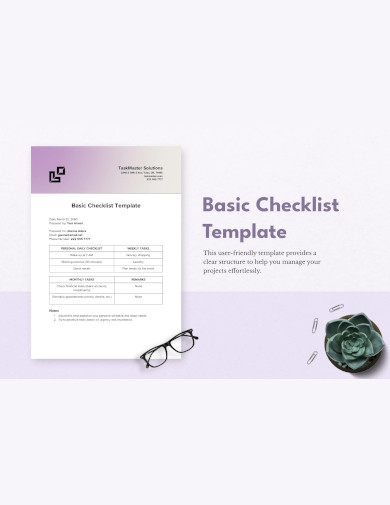
3. Formal Checklist Template
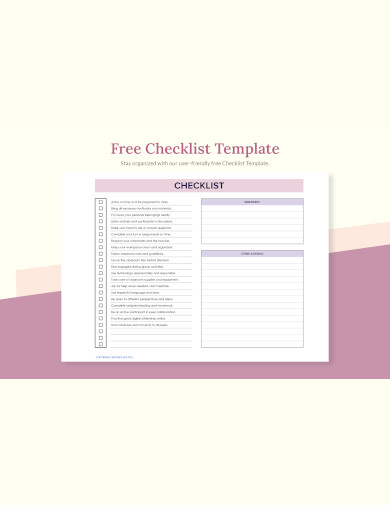
4. Printable Checklist Template
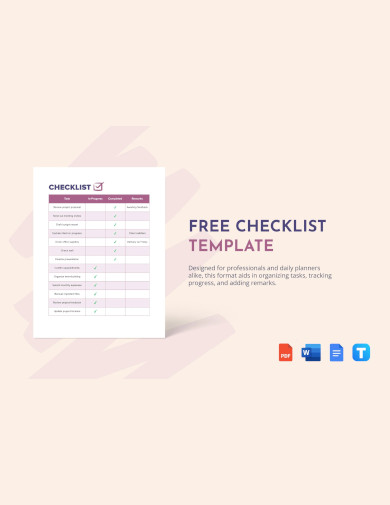
5. Voluntary Disclosure Request Checklist Template
What is a Request Checklist?
Understanding a Request Checklist
In the dynamic world of business, project management, and everyday tasks, a “Request Checklist” serves as a critical tool. But what exactly is it, and how can individuals and businesses benefit from it?
Defining a Request Checklist
A Request Checklist is a structured list of items, steps, or requirements that need to be addressed or fulfilled before a particular task, process, or request can be considered complete. It’s a way to ensure nothing is overlooked, and everything is done according to the necessary standards or specifications.
Purpose of a Request Checklist
A Request Checklist serves as a structured tool designed to systematically guide individuals or teams through tasks, processes, or requests. Its purpose extends beyond merely listing steps or items. Here are the primary purposes and benefits of using such a printable checklist:
- Ensuring Completeness: One of the main purposes of a Request Checklist is to ensure that every step, task, or requirement associated with a process or request is addressed. It ensures nothing gets overlooked, especially in complex procedures where missing a single step can lead to significant challenges.
- Promoting Consistency and Standardization: For operations that need to be repeated consistently, such as in a manufacturing setup or within certain service sectors, a Request Checklist ensures every iteration adheres to the same standard and quality.
- Enhancing Accountability: With a clear delineation of what needs to be achieved, individuals or teams can be held responsible for specific items on the checklist. This can be crucial in tasks where precision and attention to detail are imperative.
- Reducing Errors: By providing a standardized sequence or set of guidelines, the checklist minimizes the chances of mistakes, which can be especially valuable in high-stakes environments, like healthcare or aviation. You can also see more templates like Validation Checklist Samples.
- Boosting Efficiency: By serving as a quick reference, a checklist can expedite processes. Instead of constantly revisiting and reassessing what needs to be done next, the user can proceed with confidence, knowing they are on the right track.
- Facilitating Training: For newcomers or individuals unfamiliar with a specific task, a checklist acts as a training tool, helping them understand the steps involved and ensuring they carry out their duties according to established protocols.
- Providing a Sense of Accomplishment: As items are checked off, individuals often feel a sense of progress and achievement, which can be motivating, especially for long or tedious tasks.
- Aiding in Documentation and Review: In scenarios where processes need to be audited or reviewed, having a checklist can provide a structured process documentation of what was supposed to be done, making evaluations more straightforward.
Benefits of Using a Request Checklist
- Accuracy and Efficiency: One of the primary benefits of a Request Checklist is ensuring accuracy. With a list of items to check off, users are less likely to forget or overlook an essential step or detail. This leads to a more efficient process as tasks can be completed accurately the first time around.
- Standardization: In businesses or organizations where processes need to be consistent, a Request Checklist ensures every team or individual handles requests in a uniform manner. This consistency can be crucial for quality control, training new employees, and ensuring a cohesive approach across the board.
- Accountability: With a clear list of what needs to be done, team members can be held accountable for completing each step. This can be beneficial in scenarios where a missed step could have significant implications, like in regulatory or safety protocols.
- Ease of Communication: For teams, having a Request Checklist means everyone is on the same page. If a team member is unsure about what’s next, they can refer to the checklist. It serves as a shared reference point and can reduce the potential for misunderstandings or missed communications.
Implementing a Request Checklist
When looking to implement a Request Checklist, consider the following steps:
- Identify the Process or Task: Before you can create a checklist, you need to clearly define the process or task at hand. Break it down into its essential components or stages.
- List Out All Requirements: Think about every requirement, step, or detail that must be addressed. Ensure that nothing is left out, even if it seems obvious.
- Review and Refine: Once you’ve listed out all items, review the checklist with stakeholders or team members. They might spot something you missed or suggest a more efficient order for the tasks.
- Pilot the Checklist: Before finalizing it, use the checklist for a few tasks or processes. This trial run will help identify any potential issues or areas for improvement.
- Revise as Necessary: As tasks evolve or as you receive sample feedback, be prepared to update the checklist. A good checklist is dynamic and changes with the needs of the task or organization.
Usage in Various Domains
- Business: Before launching a product or a service, businesses might have a checklist to ensure all aspects, from quality checks to marketing strategies, are in place.
- Healthcare: Surgeons and medical teams often use checklists before procedures to ensure all necessary preparations are made.
- IT & Software: Before deploying a software or an update, a checklist ensures all coding, testing, and documentation are in order.
- Event Management: Organizers use checklists to ensure all arrangements, from venue bookings to guest lists, are handled.
6. Sample Process Request Checklist Template
7. Sample Student Travel Request Checklist Template
8. Sample Quote Request Checklist Template
9. Sample Child Care Variance Request Checklist Template
10. Sample Payment Request Checklist Template
11. Sample Requisition Request Checklist Template
12. Sample Pre-Application Request Checklist Template
13. Sample Vendor Update Request Checklist Template
14. Sample Employee Request Checklist Template
15. Sample Board Funding Request Checklist Template
16. Sample Out-Patient Referral Request Checklist Template
17. Sample Clearance Request Checklist Template
18. Sample Transfer Request Checklist Template
19. Sample Document Request Checklist Template
How do you Create a Request Checklist?
Creating a request checklist can streamline the process of gathering or soliciting information, ensuring thoroughness and consistency. Such checklists are valuable in various settings, from businesses sourcing supplies to individuals planning events. Here’s how to design a robust request checklist that serves its purpose effectively:
1. Understand the Purpose of Your Checklist
Start by pinpointing exactly why you’re creating this checklist. Is it for a supply order for a company? Maybe it’s to request details about a hotel booking for a trip. Understanding the purpose will guide the content and structure of your checklist. For example, a request checklist for a wedding venue might include queries about catering, seating capacity, and audio-visual equipment.
2. List Out All Necessary Information and Details
Begin by brainstorming all the potential information or details you might need. Don’t worry about organization just yet; the key is to ensure nothing is overlooked. Using the sample wedding venue example, you’d think about parking facilities, restrictions on decorations, available dates, pricing structures, and more.
3. Categorize and Prioritize
Once you have a comprehensive sample list, categorize similar items together for clarity. Grouping related items makes the checklist more user-friendly and logical. For instance, all questions related to finances (like costs, deposit details, and refund policies) can be grouped under a “Financial” category.
Next, prioritize the items within each category based on their importance. Some details might be essential for decision-making, while others are just nice-to-have.
4. Choose a Suitable Format
Depending on its intended use, your checklist might be a printed document, a digital sample form, or an interactive online tool. Pick a format that’s convenient for both the requester and the receiver. Remember, the easier it is to use, the more likely it is that you’ll get the information you need efficiently. In our digital age, tools like Google Forms or SurveyMonkey might be handy, allowing users to quickly check off items or input necessary details.
5. Iterate and Refine
No checklist is perfect on the first try. After using it once or twice, revisit the list to see if any items were unclear or if you consistently found yourself needing additional information that wasn’t originally included. Adjust and refine your checklist based on real-world usage. Maybe you’ll discover that some questions are redundant, while others need to be more specific.
What is a Pull Request Checklist?
A pull request (often abbreviated as PR) checklist is a set of guidelines or tasks that developers follow before submitting a pull request in a version control system like Git. It ensures that the code being submitted meets the project’s standards and is ready for review.
In Conclusion, A Request Checklist is more than just a list. It’s a tool that drives accuracy, promotes consistency, and enhances communication. Whether for personal use or within a larger organization, it’s an invaluable resource for ensuring tasks and processes run smoothly and effectively. You can also see more templates like Application Checklists.
Related Posts
FREE 18+ Complaint Checklist Samples in MS Word | Google Sheets | PDF
FREE 18+ Internship Checklist Samples in MS Word | Google Docs | PDF
FREE 18+ Statement Checklist Samples in MS Word | Google Sheets | PDF
FREE 20+ Voluntary Checklist Samples in MS Word | Google Sheets | PDF
FREE 18+ Summary Checklist Samples in MS Word | Google Sheets | PDF
FREE 14+ Sponsorship Checklist Samples in MS Word | MS Excel | PDF
FREE 18+ Conference Checklist Samples in MS Word | Google Sheets | PDF
FREE 17+ Lesson Checklist Samples in MS Word | Google Sheets | PDF
FREE 18+ Progress Checklist Samples in MS Word | Google Docs | PDF
FREE 18+ Enrollment Checklist Samples in MS Word | Google Docs | PDF
FREE 18+ Graduation Checklist Samples in MS Word | Google Sheets | PDF
FREE 15+ Consent Checklist Samples in MS Word | Google Sheets | PDF
FREE 18+ Review Checklist Samples in MS Word | Apple Pages | PDF
FREE 18+ Submission Checklist Samples in MS Word | Google Docs | PDF
FREE 21+ Faculty Checklist Samples in MS Word | Google Sheets | PDF

